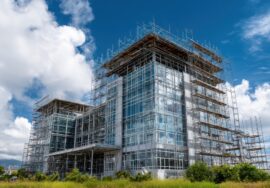Low-Carbon Footprint Buildings: Towards Sustainable Future
Low-Carbon Footprint Buildings: A Step Towards Sustainable Future
Introduction
In the era of climate change, low-carbon footprint buildings have emerged as a sustainable solution to reduce environmental impact. These buildings are designed with eco-friendly materials, energy-efficient systems, and renewable energy sources to minimize carbon emissions. As India moves towards sustainable development, adopting low-carbon footprint buildings is crucial for a greener future.
What Are Low-Carbon Footprint Buildings?
Low-carbon footprint buildings are structures designed and constructed to reduce greenhouse gas emissions throughout their lifecycle. From material selection to construction, operation, and maintenance, every aspect focuses on sustainability. These buildings incorporate renewable energy sources, smart technology, and energy-efficient materials to reduce carbon footprints.
Benefits of Low-Carbon Footprint Buildings
1. Energy Efficiency
Low-carbon buildings are equipped with smart energy solutions, such as solar panels, LED lighting, and energy-efficient HVAC systems, reducing electricity consumption.
2. Reduced Greenhouse Gas Emissions
By using renewable energy and eco-friendly materials, these buildings contribute to a significant reduction in CO2 emissions.
3. Cost Savings
Although the initial investment may be higher, low-carbon buildings save money in the long run through reduced energy bills and maintenance costs.
4. Health and Well-being
These buildings use non-toxic materials and proper ventilation systems, ensuring better indoor air quality and enhancing occupant health.
Key Elements of Low-Carbon Footprint Buildings
1. Sustainable Building Materials
- Use of recycled materials such as reclaimed wood, bamboo, and recycled steel.
- Adoption of green construction materials like fly ash bricks and low-carbon concrete.
2. Energy-Efficient Systems
- Integration of smart building solutions such as automated lighting and energy management systems.
- Use of LED lighting and motion sensors to optimize electricity consumption.
3. Renewable Energy Integration
- Installing solar-powered systems to generate clean energy.
- Utilizing wind or geothermal energy for additional sustainability.
4. Water Conservation Strategies
- Implementation of rainwater harvesting systems.
- Use of water-efficient fixtures and greywater recycling.
Low-Carbon Building Practices in India
Government Initiatives and Policies
The Indian government has introduced various initiatives to promote low-carbon buildings:
- Energy Conservation Building Code (ECBC): Aimed at improving energy efficiency in commercial buildings.
- Green Rating for Integrated Habitat Assessment (GRIHA): A national rating system to evaluate the sustainability of buildings.

Case Studies of Low-Carbon Buildings in India
Several Indian cities have adopted sustainable construction practices. For example:
- Indira Paryavaran Bhawan, Delhi: India’s first net-zero energy building.
- Suzlon One Earth, Pune: A corporate campus with renewable energy integration and sustainable design.
The Future of Low-Carbon Buildings in India
With urbanization on the rise, adopting low-carbon footprint buildings is essential for a sustainable future. The integration of smart technology, eco-friendly materials, and renewable energy will drive the transformation of the construction industry.
Conclusion
Low-carbon footprint buildings play a vital role in mitigating climate change and promoting sustainability. By incorporating green construction materials, renewable energy, and energy-efficient systems, we can reduce carbon footprints and build a greener future. To learn more about sustainable building solutions, contact us here.
References
For further reading, check out these Indian sources:
Construction Industry in India
- One of India’s largest construction and engineering companies, Campus Construction Cost Optimization provides services including project management, cost control, and engineering consultancy. For detailed information on their offerings, visit. Construction Industry in India
Read more related articles to enhance your knowledge and make informed decisions
10 Essential Steps in the Building Construction Process
How to Choose the Right Materials for Your Construction Project









